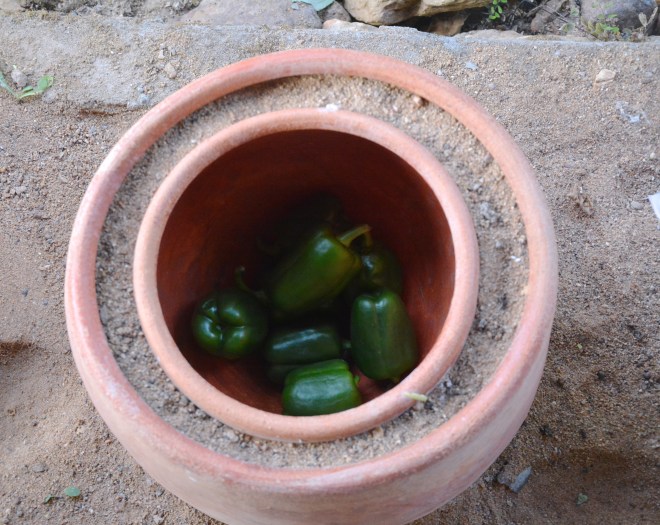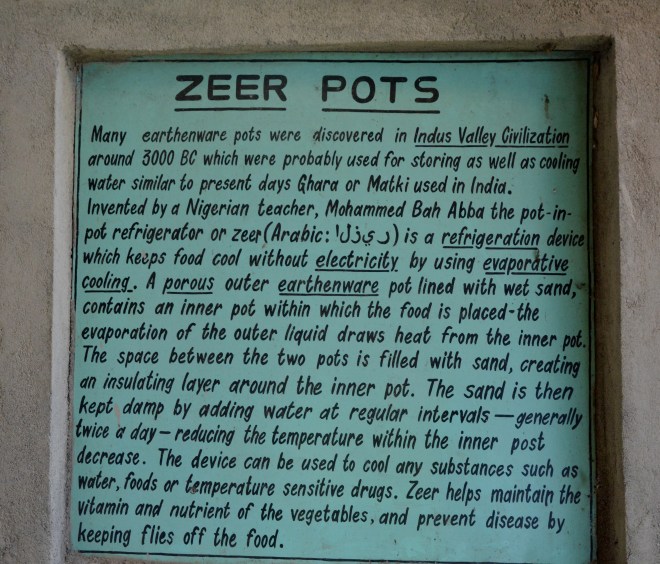In my last post on Chitvan Jungle Lodge, located at Kanha in Madhya Pradesh, India, I promised you to share the tribal village technique of keeping vegetables fresh for days together without a refrigerator. Today I am going to throw some light on how it is being done through the photos I clicked. My old followers already know about the serenity of Chitvan, the new friends who have missed the previous post, can click here to have a detailed information about this one of the finest hotels amidst thick green forests and adjoining the core forest area of picturesque tiger forests of Kanha of India.Â
The world seems to be going green. People love to spend holidays in natural surroundings where the children and the families can have first hand experience of rural life. One such experience I had during my stay in Chitvan. This was a moment in time.
We reached there in the afternoon, had lunch, went to room, freshen up to take a view of property. As soon as we reached the organic farm we were delighted to see so many herbs and medicinal plants,a  panacea for many diseases. In one corner we saw these amazing pots, (invented by Nigerian teacher, Mohammed Bah Abba, being used by local villagers) to keep their vegetables fresh for weeks  just like any other electric refrigerator.
 Â This is a sort of home made fridge also known as Pot-In-Pot refrigerator or Clay pot cooler. It can be used to cool any substance. It only requires flow of dry air and source of water can save heavy electricity bills.Â
 This is a sort of home made fridge also known as Pot-In-Pot refrigerator or Clay pot cooler. It can be used to cool any substance. It only requires flow of dry air and source of water can save heavy electricity bills.Â
History of Jeer Pots:
There is some evidence that evaporative cooling was used as early as the Old Kingdom of Egypt, around 2500 B.C. Frescos show slaves fanning water jars, which would increase air flow around the porous jars and aid evaporation, cooling the contents. Later with the invention of modern electric refrigerators this technology was probably forgotten, tribals from different countries continued to rely on these pots for preserving food.
This history was placed near the pots for Chitvan tourists who are keen to know more about it.
How to make your own Zeer Pots:
Firstly place a large clay pot which fits in another larger clay pot with a lid.
Fill the space between the two pots with sand, creating an insulating layer around the inner pot.
Now keep the sand damp by adding water at regular intervals generally twice a day. It reduces the temperature within the inner pot.
If lid is not available then put wet cloth on top.
Hey the pot is ready to place vegetables in it. Each zeer can contain 12 kg of vegetables.
Cost:
Less than US$2/ approx Rs.160 to produce. As the water evaporates the device gets cool to allow refrigeration in hot, dry climate.
Do’s & Don’ts
You can glaze the inner pot to prevent the penetration by the liquid.
Preferably place it in a dry, ventilated space for the water to evaporate effectively towards the outside.
It is not effective, performs poorly in areas having high humidity since the water is not able to evaporate well under these conditions.
Do not over stuff the inner pot.
Benefits;
It helps maintain the vitamin and nutrient content of the vegetables, and prevent disease by keeping flies off the food.
It can be used for storing life saving drugs where electricity is not available twenty four hours.
 It protects farm fresh from humidity, keeps it dry, preventing fungi from developing.”
It is non-pollutant and eco friendly, ideal for organic world. A boon for farmers.
I hope you have enjoyed the information about Zeer pots and it will benefit you in some way. I am looking for the pots and will try to make one. If you have had any similar experience or information please share it.Â







25 Responses
Miracles of science @ your fingertips….it was refreshing piece of information. Soul I like your style of conveying good impressions of life…fabulous article
It is so nice to know the things which you might have not noticed otherwise. Love the adventure trips.
Interesting, but we have our own refrigerator outside during the Winter in Switzerland where it would all probably freeze and be too cold. Summer might be an idea, although I think my felines would have fun with the pots and so would the various insects with the food inside, although a very good idea.
We Asians do not have good fortune like Swiss folks and moreover summers just cannot be avoided in this part of world. Things start rotting as soon as you pluck them from trees. Let your felines have some fun:)
I always wondered! dang my jaw dropped when I read how easy it is to do, it’s all about transfer of the cold from moisture huh!
Yes ! Hats off to the brain behind it 🙂
This is incredible. Simple yet efficient technology cost effective, environmental friendly! Super cool. I guess it might work even in humid places!
No, I don’t think it will work effectively on humid conditions. Evaporation wont be efficient in that conditions. yes ,you are right. I missed that point 🙂
Yes it can if you take more care. cooling may take place slowly.
yea, I think so!
Fascinating! Wouldn’t work in our humid summers, but it’s till very interesting.
Yes, it is ideal for dry climate. Thanks for sharing your views.
You show us your heart along with teaching us how others do things. I really liked this post, Rashmi! You are such a wonderful storyteller, too. Hugs, Robin
I have talented well wishers like you Robin. I am glad that you liked my work. I am so blessed to hear kind words from you.
It’s a variation on a theme of the root cellar. And the desert cooler. There are lots of these “low tech” ways to cool that work. A way to save some electricity and maybe, eventually, save the planet. Great post!!
Thanks for appreciating the effort and yes people come up with so many innovative ideas to save this planet. I am so glad that you added some valuable information here.
Admire this innovative concept.
Well Done Rashmi for covering this post. Pics on this post articulated idea well.
This concept design can be replicated in designing low cost weather resistant water tanks that are placed at roof top.
It will help people get cool water in hot weather and hot water in cool weather.
No electric/gas geysers required then.
If you don’t mind, Can I use pics on my blog. Credit will be given to your blog and to your work.
Regards http://YourWellWisherProgram.Wordpress.com
Yes if you give the credit and mention my blog then it will be an honour for me. Thanks for appreciating the effort. Please send the link of your post.
great. will do that when done…
Thanks.
Very good information. Pl. share any information on price and availability of ready-made clay-pots for refrigeration purpose
How clever, Rashmik! Thank you so much for sharing it with such details. Keeping veggies and fruits in fridge is not effective since the moisture gets evaporated quickly. Thanks again!
A valuable input Amy ! Yes it is always better to go for natural options.
Informative and interesting!
I am glad to get this lovely comment from you. Thanks for visitiing.